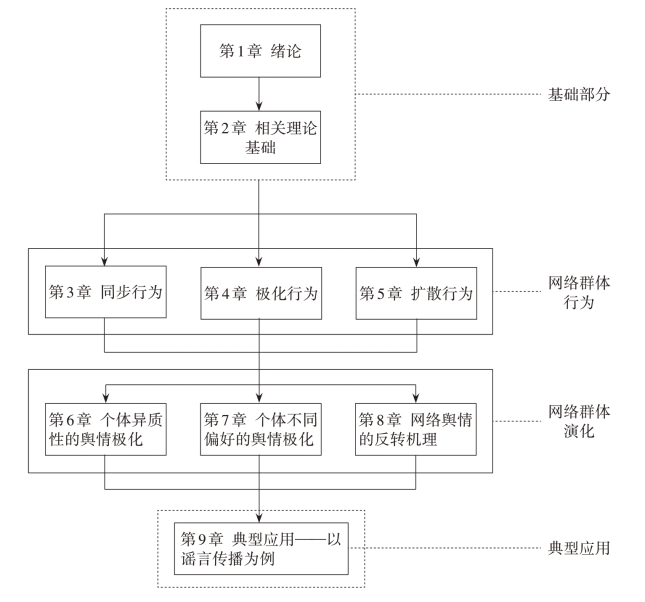本书根据书稿内容之间的逻辑联系,以第1章、第2章为基础篇,第3—5章围绕网络群体行为展开讨论,第6—8章讨论网络舆情的演化机理,第9章以谣言传播为例进行典型应用分析。全书的篇章结构如图1-1所示,其中第3—9章的内容均以作者的研究工作为基础完成,体现了本书的理论创新之处和学术价值。

图1-1 本书篇章结构
作为绪论的第1章描述了全书的概貌。第2章论述了复杂网络的基本原理,旨在为第3—8章的研究工作提供相关的理论基础。这是鉴于以下情况而设置的内容:第3—8章是全书的主体内容,其中第3—5章讨论了网络群体行为的涌现机制,主要以复杂网络为基础展开讨论;第6—8章讨论了网络舆情的演化原理,主要以网络节点态度交互为基础展开。第9章是应用案例,论述了网络舆情的典型案例分析过程。上述几章构成了本书的主体篇。
第3—8章集中展示作者在网络舆情研究方面所取得的成果,主要包括网络群体行为的涌现和网络舆情的演化两方面内容。前者以复杂网络为基础,针对网络群体的同步、极化行为展开讨论与分析,提出了网络优化与抑制机制;后者以网络群体行为为基础,针对网络舆情的形成、传播与反转等问题,采用模拟仿真与实证等方法,研究舆情的演化机理并提出有效的干预、引导机制。
第9章是典型案例,以典型的谣言传播过程为例,探讨网络舆情的扩散、演化原理,使读者从感性认识提升到理性认识,并将理论应用于实际,对本书前述章节相关模型与方法进行实际应用,检验其合理性与有效性。
作为学术研究成果的总结,本书各章内容基本自成一体,除了第1章与第2章之间、第6章与第7章之间有较强的衔接关系外,其余各章均具有相对的独立性。读者可以根据自己的兴趣有选择性地阅读有关内容,而不必拘泥于全书的编排顺序。
参考文献
[1]张耀峰.社会系统中集群行为的涌现计算[D].武汉:华中科技大学,2015.
[2]BARRYS.Collectivememory and history:how abraham lincolnbecamea symbolof racialequality[J].SociologicalQuarterly,1997(38):469-496.
[3]JACKSON M O.Social and econom ic networks[M].Princetors,New Jersey,USA:Vtls Inc,2013.
[4]张树人,方美琪.Web2.0与信息系统复杂性变革[M].北京:科学出版社,2008.
[5]曾庆香,李蔚.群体性事件:信息传播与政府应对[M].北京:中国书籍出版社,2010.
[6]付琳.人肉搜索私力救济性对公权力的补足作用[J].学习论坛,2017,33(5):75-80.
[7]WATTS D J.The“new”science of networks[J].Annual Review of Sociology,2004,30:243-270.
[8]HOLLAND JH.Hidden order:how adaptation builds complexity[M].New Jersey:Addison-Wesley,1995.
[9]HOLLAND JH.Emergence[M].New York:Addison-Wesley,1998.
[10]戴存礼.复杂网络上动力学系统的同步行为研究[D].南京:南京航空航天大学,2008.
[11]LYMPEROPOULOSI,LEKAKOSG.Analysisofsocialnetwork dynamics w ith models from the theory of complex adaptive systems[C]//Conference on e-Business,e-Servicesande-Society.SpringerBerlinHeidelberg,2013:124-140.
[12]PAN Y,TANW,CHEN Y.The analysis of key nodes in complex social networks[C]//InternationalConferenceon Cloud Computing and Security.Springer,Cham,2017:829-836.
[13]YEX,FEIC.Researchesonevaluationsof large-scalecomplexnetworks topologies[C].ProcediaComputerScience,2017,107:577-583.
[14]孙冰,田胜男,姚波涛.创新网络的小世界效应如何影响突围性技术扩散——基于转换模式成本的调节作用[J].管理评论,2018,30(3):72-81.
[15]M ITRAC,KURTHSJ,DONNERRV.Rew iring hierarchicalscale-free networks:influence on synchronizability and topology[J].Epl,2017,119(3):29-37.
[16]WATTSD J,STROGATZ SH.Collective dynam ics of“small-world”networks[J].Nature,1998,393(6684):440-442.
[17]BARABÁSIAL,ALBERTR.Emergenceofscaling in random networks[J].Science,1999,286(5439):509.
[18]LIC,JIANG G,SONG Y,et al.M odeling and analysis of epidem ic spreading on community networksw ith heterogeneity[J].Journal of Parallel&DistributedComputing,2018,105(9):211-223.
[19]MEDVEDEVGS,TANGX.Thekuramotomodelon power law graphs:synchronizationand contraststates[J].JournalofNonlinearScience,2018,27(4):1-23.
[20]PLUCHINOA,LATORA V,RAPISARDA A.Changing opinions in a changing world:a new perspective in sociophysics[J].International Journal of Modern Physics C,2005,16(4):515-531.
[21]HONGH,KIM BJ,CHOIM Y.Factorsthatpredictbettersynchronizability on complex networks[J].Physical Review E:Statistical Nonlinear&Soft Matter Physics,2004,69(6):067105.
[22]SUEUR C.Self-organization in primates:understanding the rules underlying collectivemovements[J].International Journal of Primatology,2011,32(6):1413-1432.
[23]RODRIGUESFA,PERON TK D,JIP,etal.The kuramotomodel in complexnetworks[J].PhysicsReports,2016,610:1-98.
[24]SONGX,SHIW,MAY,etal.Impactof informalnetworkson opinion dynam icsinhierarchically formalorganization[J].PhysicaA:StatisticalMechanics&itsApplications,2015,436:916-924.
[25]LIJ,MYERSSC.R2 around theworld:new theory and new tests[J].Journalof FinancialEconom ics,2006,79(2):257-292.
[26]YAW MW,CHONG K H,KAM ILK.Transform of artificial immune system algorithm optim ization based on mathematical test function[C].IEEE InternationalConferenceon ControlSystem,Computing and Engineering,2017:147-150.(www.xing528.com)
[27]MLUNGISI D,BHEKISIPHO T.Optim ising latent features using artificial immune system in collaborative filtering for recommender systems[J].Applied Soft Computing,2018,71:183-198.
[28]CHENW,LIT.Parameteranalysisof negative selection algorithm[J].InformationSciences,2017,420:218-234.
[29]ZAREIZADEH Z,HELFROUSH M S,RAHIDEH A,etal.A robust gene clustering algorithm based on clonal selection inmultiobjective optim ization framework[J].ExpertSystemsw ithApplications,2018,113:301-314.
[30]LIN Q,MA Y,CHEN J,et al.An adaptive immune-inspired multiobjective algorithm w ithmultiple differentialevolution strategies[J].Information Sciences,2018,431:46-64.
[31]TAYEB B S,BESSEDIK M,BENBOUZID M,et al.Research on permutation flow-shop scheduling problem based on improved genetic immune algorithm w ith vaccinated offspring[J].Procedia Computer Science,2017,112:427-436.
[32]JU C,CHEN T.Simplifyingmultiprojectscheduling problem based on design structurematrix and itssolutionby an improved aiNetalgorithm[J].Discrete Dynam icsinNatureand Society,2012:22
[33]KLEINER TM.Public opinion polarisation and protestbehaviour[J].European JournalofPoliticalResearch,2018,57(4):941-962.
[34]王宏波,吴雪芹.群体性事件舆情传播极化现象评析[J].西安交通大学学报(社会科学版),2013,33(1):65-70.
[35]焦德武.试论网络传播中的群体极化现象[J].安徽理工大学学报(社会科学版),2010,12(3):105-108.
[36]史波.网络舆情群体极化的动力机制与调控策略研究[J].情报杂志,2010,29(7):50-53.
[37]张桂霞.网络舆情主体的群体极化倾向分析[J].青岛科技大学(社会科学版),2005,21(4):104-107.
[38]刘青.网络群体极化现象研究综述[J].北京警察学院学报,2013,14(3):74-79.
[39]郭小平.信息的“协同过滤”与网民的“群体极化”倾向[J].东南传播,2006,34(12):43-44.
[40]ASCH SE.Effectsofgroup pressureupon themodificationand distortion of judgments[M].CarnegiePress,1951.
[41]ASCH SE.Studiesof independenceand conform ity:i.am inority ofone againstaunanimousmajority[J].PsychologicalMonographs,1956,70(9):1-70.
[42]DEFFUANTG,NEAU D,AMBLARD F,etal.M ixing beliefsamong interactingagents[J].AdvancesinComplex Systems,2000,3(1-4):87-98.
[43]WEISBUCH G,DEFFUANTG,AMBLARD F,etal.Meet,discuss,and segregate![J].Complexity,2002,7(3):55-63.
[44]JAGERW,AMBLARD F.Uniform ity,bipolarization and pluriform ity captured as generic stylized behavior w ith an agent-based simulation model of attitudechange[J].Computational&MathematicalOrganization Theory,2005,10(4):295-303.
[45]CHAU H F,WONG C Y,CHOW FK,etal.Social judgment theory based model on opinion formation,polarization and evolution[J].Physica A Statistical Mechanics&its Applications,2014,415:133-140.
[46]LI J,XIAO R.Agent-basedmodelling approach formultidimensional opinion polarization in collective behaviour[J].Journal of Artificial Societies&Social Simulation,2017,20(2):14.
[47]YANAGIMOTOH,YOSHIOKAM.Relationship strengthestimation for social media using folksonomy and network analysis[C].IEEE International Conferenceon Fuzzy Systems.IEEE,2012:1-8.
[48]林芹,郭东强.优化SIS模型的社交网络舆情传播研究——基于用户心理特征[J].情报科学,2017,35(3):53-56.
[49]陈波,于泠,刘君亭,等.泛在媒体环境下的网络舆情传播控制模型[J].系统工程理论与实践,2011,31(11):2140-2150.
[50]彭慧洁,朱君璇.基于在线社交网络的D-SIR信息传播模型研究[J].电子科技,2017,30(5):172-175.
[51]赵剑华,万克文.基于信息传播模型SIR传染病模型的社交网络舆情传播动力学模型研究[J].情报科学,2017,35(12):34-38.
[52]朱恒民,杨柳,马静,等.基于耦合网络的线上线下互动舆情传播模型研究[J].情报杂志,2016,35(2):139-144.
[53]黄微,宋先智,高俊峰.网络舆情场中信息受众观点群落的连接鲁棒性测度及实证研究[J].情报学报,2017,36(5):503-510.
[54]HUANGC,HUB,JIANGG,etal.Modelingofagent-based complexnetwork undercyber-violence[J].Physica A:StatisticalMechanicsand itsApplications,2016,458:399-411.
[55]ZHU H,HU B.Impact of information on public opinion reversal—an agentbasedmodel[J].PhysicaA:StatisticalMechanicsand itsApplications,2018,512:578-587.
[56]FLACHE A.About renegades and outgroup haters:modeling the link between social influence and intergroup attitudes[J].Advances in Complex Systems,2018,21(6-7):1850017.
[57]DUNNE T C.Friend or foe?a reversal of ingroup bias[J].Group Decisionand Negotiation,2018,27(4):593-610.
[58]DENG L,LIU Y,ZENG Q A.How information influencesan individual opinion evolution[J].PhysicaA:StatisticalMechanicsand itsApplications,2012,391(24):6409-6417.
[59]LERMANAE,MCCABEK T.Personalexperienceand publicopinion:atheoryand testofconditionalpolicy feedback[J].The JournalofPolitics,2017,79(2):624-641.
免责声明:以上内容源自网络,版权归原作者所有,如有侵犯您的原创版权请告知,我们将尽快删除相关内容。














